History
In 2014 the Sarjeant Gallery Te Whare o Rehua Whanganui’s heritage building was identified as an ‘earthquake-prone’ building and closed to the public. During this time there was an urgent need for online access to the collection as the temporary exhibition space is significantly restricted.
This posed a challenge with limited resources available:
- Time: Four months from conception to website launch
- People: A small team of about 11 staff with no in-house IT or design staff
- Money: A budget of $15,000 (USD).
Solution
The Sarjeant Gallery worked together with Vernon CMS to build a microsite using the Brower module. The gallery’s small team did not have enough resources to spend hours retrospectively inputting relevant data and keywords into the collection records, so ways were needed to quickly clean up the data and prioritise copyright clearance with the artists. A range of tactics were used to meet that goal.
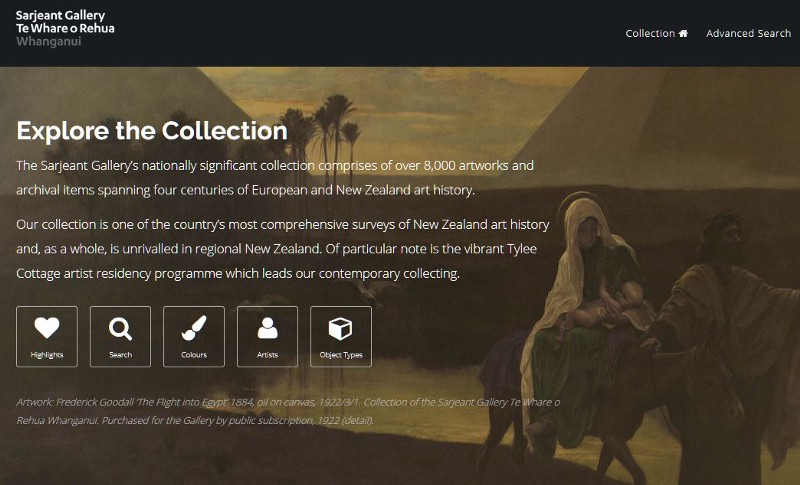
Prototyping
It all starts with a well-defined plan and clear communication. The site is built on in Browser module template pages so the first step was to build a working wireframe using unbranded templates. This was immediately married to collection data from the Sarjeant Gallery’s Vernon CMS database. Several iterations of exporting and exploring this collection data revealed its strengths and weaknesses. From here a plan was made around the most usable data and where time and effort could be directed for the greatest result.
For example, about 100 artists represented the majority of the objects in the collection. Rather than recreating information about these artists, external sources such as Wikipedia and Te Ara (the encyclopaedia of New Zealand) were linked to from the artist pages. An additional benefit of the external Wikipedia links are that they have become the second most common source website through which visitors discover the gallery’s online collection.
Explore by colour and by subject tags
One of the main goals was to build a variety of options for visitors to explore the collection online. John Falk’s research on museum visitor types was used as one way to assess the potential features. For example, allowing the ‘Explorer’ type visitors to browse the collection by attributes such as colour or subject tags, while still offering advanced search screen to meet the needs of ‘Professionals’ researching the collection.
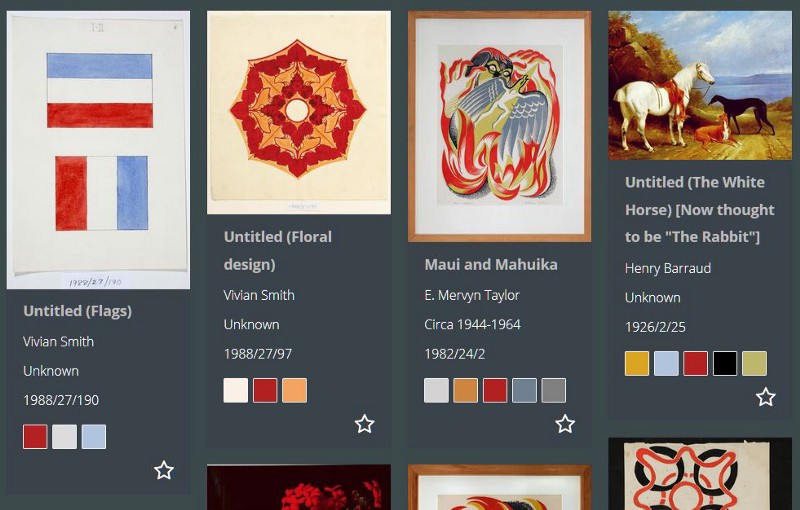
Colour information was added to the collection data as part of the process. Several challenges were met, such as refining these colours down from the original 16 million palette to a final palette of 139 named colours.
Google Cloud Vision was used to automatically add subject tags. Options were added for the curators to remove specific keywords from an artwork or the whole website when the keyword doesn’t make sense. The original plan was to make the tags a private field to aid the curators, but the results were above expectations so the decision was made to make them public.
The resulting tags added a layer of information on top of the existing collection data. A visitor can enter a natural language term, such as “moustache” to retrieve related records.
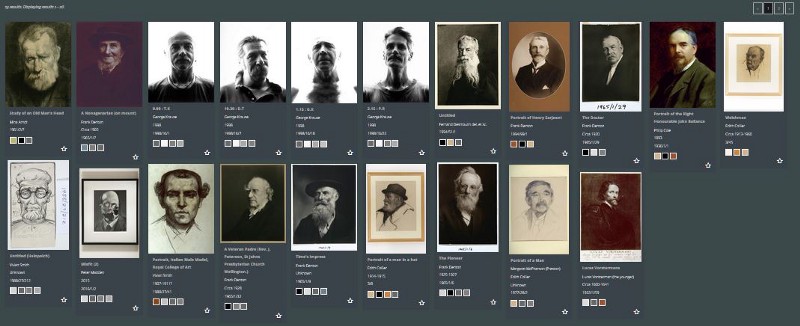
Natural language and readability
Descriptions are an important entry point for users but there was a lack of detailed curatorial descriptions across the collection. Like most internal catalogues, the source data can appear dry and formal so another solution had to be found. We took inspiration from the Cooper Hewitt online collection’s use of natural language. We combined the object type, production place and production date data into a sentence on the page for each artwork. By doing an automated search on the object type, we were able to display a count of the related artworks of the same type. This met the goals of giving the user a scale of the collection and also avoiding any dead ends. Object type and production place both appear as links so that the visitor can easily jump to all the artworks of the same category.
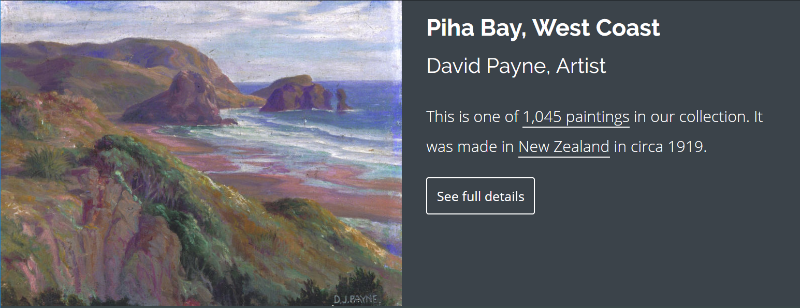
You can experience the Sarjeant Gallery’s online collection yourself and tell us what you think. More in-depth articles about the publishing the Sarjeant Gallery’s online collection can be found at Looking at Sarjeant Gallery’s collection through robot eyes and Building an accessible online collection of Sarjeant Gallery.
Developments after the initial launch
With the finished website, we have embraced the concept of “Create Once, Publish Everywhere”. Gallery staff are using the online collection to engage the public in different ways, such as sharing on their social media feed a set of works featuring moustaches as part of the Movember event (Movember is an annual New Zealand event involving the growing of moustaches during the month of November to raise awareness of men’s health issues). This grouping of works was possible because of the Google Cloud Vision subject tags, searching on the tag ‘facial hair’.
One of the most exciting outcomes has been using the new site to engage with the collection in different ways than were possible previously, particularly using the Highlights section of the site. The Gallery has developed several initiatives as a result, including the Collection Focus series which highlights works by a featured artist from the collection online and is also accompanied by a physical exhibition. Next year the Gallery will launch a new initiative called My Choice which gives the public opportunities to make their own selections of works for display in a virtual exhibition online. The person making the selection will add their own personal comments about each work and why it appeals to them.
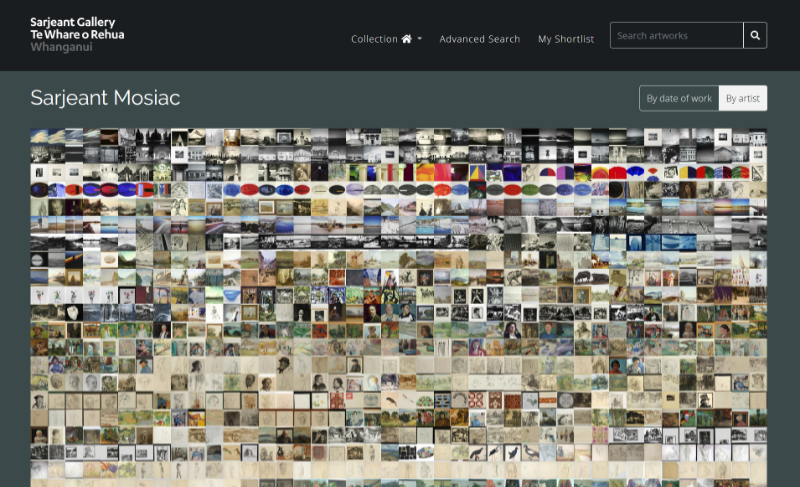
We’re excited to have launched a new feature in December 2018 called Sarjeant Mosaic. This provides an overview of all the collection images on one screen, sorted by either production date or by artist surname. You can easily pick out artists that have a distinctive style, such as the coloured ovals used by Gretchen Albrecht in the third row. This kind of view provides another way for visitors to zero in on a work that interests them. If they click on a small thumbnail it brings up a larger preview, from which the viewer accesses the detail page about the artwork.
[…] The Sarjeant Gallery worked together with Vernon CMS to build a microsite using the Brower module. The budget constraints meant that there were not enough resources to spend hour’s retrospectively inputting relevant data and keywords into the collection records, so …Read more… […]